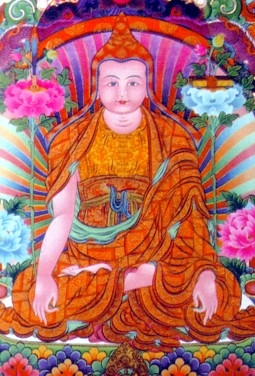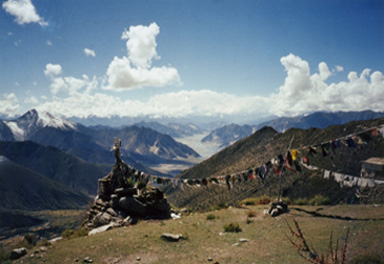Longchenpa


Longchenpa (Wyl. klong chen pa), also known as Longchen Rabjam, ‘Infinite, Vast Expanse of Space’, or Drimé Özer (1308-1364), was one of the most brilliant teachers of the Nyingma lineage. He systematized the Nyingma teachings in his ‘Seven Treasures’ and wrote extensively on Dzogchen. He transmitted the Longchen Nyingtik cycle of teachings and practice to Jikmé Lingpa, and it has since become one of the most widely practised of traditions.
Sogyal Rinpoche writes:
- The figure of Longchen Rabjam stands out as one of the greatest Dzogchen masters in the Nyingma tradition, and amongst the most brilliant and original writers in Tibetan Buddhist literature. He was the author of over 200 works, of which only about twenty-five survive, and amongst which the Seven Treasuries (Dzö Dun) and Three Trilogies are most well-known. It was he who brought together into a cohesive system the teachings of Vima Nyingtik and Khandro Nyingtik, on which he wrote the ‘Three Yangtik’ or Inner Essences.
- As Nyoshul Khen Rinpoche explains: “Kunkhyen Longchenpa’s Seven Treasuries (Dzö Dun) were written to elucidate the extraordinarily profound meaning of the seventeen main Tantras of Dzogpachenpo as well as the teachings of all Nine Yanas. For the purpose of the actual practice of Dzogchen according to these Tantras, Longchenpa gathered his own termas as well as those of Chetsün Senge Wangchuk (who was later reborn as Jamyang Khyentse Wangpo) and Pema Lédrel Tsal (Longchenpa’s previous incarnation) in the form of the thirteen volume collection known as the Nyingtik Yabshyi. This Yabshyi is the practice aspect of Longchenpa’s writings, and the basis of the Old Nyingtik. In it he synthesized the Vima Nyingtik of Vimalamitra and the Khandro Nyingtik of Guru Rinpoche and explained all the practical details in the light of his own realization.”[1]
His Writings
- Seven Treasures
- The Wish Fulfilling Treasury (Tib. Yishyin Dzö; Wyl. yid bzhin mdzod)
- The Treasury of Pith Instructions (Tib. Mengak Dzö; Wyl. man ngag mdzod)
- The Treasury of Dharmadhatu (Tib. Chöying Dzö; Wyl. chos dbyings mdzod)
- The Treasury of Philosophical Tenets (Tib. Drubta Dzö; Wyl. grub mtha' mdzod)
- The Treasury of the Supreme Vehicle (Tib. Tekchok Dzö; Wyl. theg mchog mdzod)
- The Treasury of Word and Meaning (Tib. Tsik Dön Dzö; Wyl. tshig don mdzod)
- The Treasury of the Natural State (Tib. Neluk Dzö; Wyl. gnas lugs mdzod)
- Trilogy of Dispelling Darkness
- Dispelling Darkness in the Ten Directions (gsang snying 'grel pa phyogs bcu mun sel)
- Dispelling Darkness of the Mind (gsang snying spyi don yid kyi mun sel)
- Dispelling Darkness of Ignorance (gsang snying bsdus don ma rig mun sel)
- Trilogy of Finding Comfort and Ease
- Finding Comfort and Ease in the Nature of Mind (Wyl. sems nyid ngal gso)
- Finding Comfort and Ease in Meditation (Wyl. bsam gtan ngal gso)
- Finding Comfort and Ease in the Illusoriness of Things (Wyl. sgyu ma ngal gso)
- Trilogy of Natural Freedom
- The Natural Freedom of the Nature of Mind (Semnyi Rangdrol)
- The Natural Freedom of Reality (Chönyi Rangdrol)
- The Natural Freedom of Equality (Nyamnyi Rangdrol)
- A Collection of Writings (Wyl. gsung thor bu)
Alternative Names
Longchenpa used several different names in the colophons to his writings, often corresponding to the subject matter of the text:[2]
- Dorje Ziji (rdo rje gzi brjid) for writings common to both outer and inner tantras.
- Drimé Özer (dri med 'od zer) for writings on profound subjects and especially the stages of meditation.
- Longchen Rabjam (klong chen rab 'byams) for writings in which the inconceivable nature is taught in detail.
- Kunkhyen Ngakgi Wangpo (kun mkhyen ngag gi dbang po) for writings in which the various yanas and views are explained in detail.
- Tsultrim Lodrö (tshul khrims blo gros) or Samyepa Tsultrim Lodrö, for writings on the outer sciences.
Notes
- ↑ Dzogchen and Padmasambhava
- ↑ Tulku Thondup, The Practice of Dzogchen, p.188
Further Reading
In English
- Dudjom Rinpoche, The Nyingma School of Tibetan Buddhism, Its Fundamentals and History, trans. and ed. Gyurme Dorje (Boston: Wisdom, 1991), pp.575-596
- Klong-chen rab-'byams-pa, Looking Deeper: A Swan's Questions and Answers, translated by Herbert V. Guenther, Timeless Books, 1983
- Longchen Rabjampa, 'The Four-Themed Precious Garland: An Introduction to Dzogchen, with commentaries by Dudjom Rinpoche and Beru Khyentse Rinpoche; translated by Alexander Berzin, LTWA, 1978
- Longchenpa, You Are the Eyes of the World, translated by Kennard Lipman and Merrill Peterson, Snow Lion, 2000
- Nyoshul Khenpo, A Marvelous Garland of Rare Gems: Biographies of Masters of Awareness in the Dzogchen Lineage, Padma Publications, 2005
- Smith, E. Gene, 'Klong chen Rab 'byams pa and His Works' in Among Tibetan Texts, Wisdom, 2001
- Tulku Thondup, Masters of Meditation and Miracles, Shambhala, pages 109-117.
- Tulku Thondup, The Practice of Dzogchen, Ithaca: Snow Lion, 1989
In French
- Stéphane Arguillère, Vaste sphère de profusion, Klong-chen rab-'byams (Tibet, 1308-1364), sa vie, son oeuvre, sa doctrine, Orientalia Analecta Lovaniensa 167, Leiden: Peeters, 2007